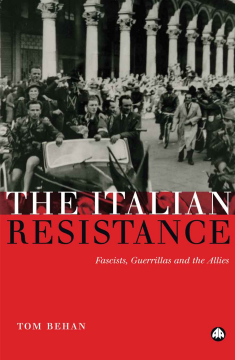
Additional Information
Book Details
Abstract
One of the enduring myths about World War Two is that the Allies alone liberated occupied Europe. However, many countries had successful anti-fascist movements, and Italy's was one of the biggest and most politically radical. Yet it remains relatively unknown outside of its own homeland.
Tom Behan tells this inspiring history. Within Italy many plaques and streets commemorate the actions of the partisans - a movement from below that grew as Mussolini's dictatorship unravelled. Led by radical left forces, the Resistance trod a thin line between fighting their enemies at home and maintaining an uneasy working relationship with the Allies.
Through the use of unpublished archival material and interviews with surviving partisans, this is an inspiring story of liberation.
'At a time when the Italian Resistance is under attack from all quarters, Tom Behan's clear and accessible book is a trenchant reminder that the movement had great moral, historical and political significance'
Dr Phil Cooke, Senior Lecturer in Italian Studies, University of Strathclyde, editor of The Italian Resistance: An Anthology (1998).
'This is the book on mid-twentieth century Italian history I have been waiting for'
Dr Gerd-Rainer Horn, Senior Lecturer, Department of History, Universityof Warwick
Table of Contents
| Section Title | Page | Action | Price |
|---|---|---|---|
| Cover | Cover | ||
| Contents | v | ||
| List of Illustrations | vii | ||
| Abbreviations | x | ||
| Acknowledgements | xi | ||
| Chronology | xii | ||
| Introduction | 1 | ||
| The meaning of the Resistance | 4 | ||
| How this book is structured | 5 | ||
| Part I | 7 | ||
| 1. Midnight in the Century | 9 | ||
| Italian colonialism, racism and the Second World War | 13 | ||
| The ice melts | 20 | ||
| 2. The Mafia and Street Kids: How Fascism Fell in the South | 22 | ||
| The liberation of Sicily | 22 | ||
| 25 July 1943: the dall of Mussolini and 'the end of the beginning' | 25 | ||
| 8 September 1943: the fall of fascism | 28 | ||
| Four days in Naples | 32 | ||
| 3. People, Parties and Partisans | 40 | ||
| The March 1943 strikes | 40 | ||
| The birth of a national unified movement | 44 | ||
| The Socialist Party | 45 | ||
| The Action Party | 47 | ||
| The Communist Party | 49 | ||
| The CLN | 52 | ||
| Anti-fascism on the ground | 53 | ||
| The three wars | 56 | ||
| 4. Resistance in the Mountains | 61 | ||
| A new kind of army | 67 | ||
| Why the partisans were successful | 75 | ||
| 5. Resistance in the Cities | 77 | ||
| Strike action in the cities | 79 | ||
| The liberation of Florence | 85 | ||
| 6. ‘Aldo says 26 for one’ | 93 | ||
| Spring comes in many colours | 96 | ||
| All that glitters is not gold | 105 | ||
| 7. Postwar Partisan Activity | 107 | ||
| Why partisans were angry | 107 | ||
| Political violence after liberation | 109 | ||
| Legal attacks on partisans | 114 | ||
| Partisan rebellions | 118 | ||
| The non-monolithic Communist Party | 123 | ||
| Occupationn and Insurrection, 1947-48 | 126 | ||
| The end of the Resistance? | 136 | ||
| 8. The Long Liberation | 138 | ||
| Italian fascism, down but not out | 138 | ||
| The Tambroni affair | 141 | ||
| Attempted coups | 144 | ||
| The strategy of tension | 145 | ||
| The political defrosting of the MSI | 148 | ||
| The undermining of the Resistance | 151 | ||
| Part II | 159 | ||
| 9. Female Fighters | 161 | ||
| Non-military activities | 163 | ||
| Military activities | 169 | ||
| Military versus wimen's liberation | 171 | ||
| 10. The Partisan Republics | 175 | ||
| The Montefiorino republic | 176 | ||
| The republic of Carnia | 178 | ||
| The Ossola republic | 180 | ||
| 11. Organising ‘Terrorism’ | 190 | ||
| A tale of two cities | 197 | ||
| 12. An Uneasy Alliance:The Resistance and the Allies | 208 | ||
| An alliance for military needs | 209 | ||
| Between a rock and a hard place: the resistance and the Rome protocols | 212 | ||
| The Allies' political strategy | 216 | ||
| Conclusion | 224 | ||
| Notes | 229 | ||
| Index | 253 |
